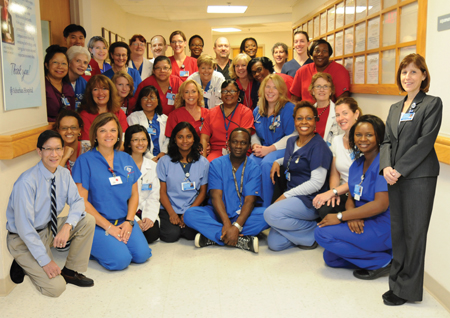Suburban’s ICU Wins National Award
by Rich Shea
In 2008, Kimberley Kelly and several of her staff at Suburban Hospital’s ICU attended a dinner hosted by the American Association of Critical-Care Nurses (AACN), which was honoring regional recipients of its Beacon Award, given to units meeting a rigorous set of safety, organizational and leadership standards. Beacon winners, as the award’s name implies, serve as models nationwide. And Kelly, who had signed on as nursing director in 2005, when morale in the ICU was low due to staff and management turnover, realized something.

“I felt like, ‘We can do this,’” Kelly, MBA, RN, CCRN, recalls. “‘We can check off 75 percent of these standards we’re already meeting.’ We had lots of energy, and the unit had stabilized at that point.”
Two years later, after undergoing an 18-month application process, Suburban’s ICU—along with Johns Hopkins Hospital’s ICU—was indeed awarded a Beacon, which, as AACN’s president, Kristine Peterson, states, “represents extraordinary commitment to high-quality critical care standards.” So, what did Kelly and her crew of 75 nurses do to clinch the award?
“Our biggest challenge was critical-care certification of staff,” says Kelly. The Beacon standard is 65 percent, and at the time only four nurses on the 24-bed unit, which serves 2,000 patients a year, were certified. But the AACN also credits units actively seeking improvement. And in two years Suburban’s ICU upped its certification number to 25 by having in-house experts teach nurses, who also listened to test-prep CDs during their commutes. “It’s a lot of work,” Kelly concedes, “but now the expectation is to get your certification.”
Suburban’s 67-page Beacon application lists many other reasons for award qualification. The turnover problem Kelly once faced, for example, was resolved by having senior nurses help prepare student nurses and travelers to become permanent staff members. The result: the staff vacancy rate, at 40 percent in 2005, is now 9 percent, and the once 27-percent turnover rate is 8 percent.
Collaboration also extends to education, for which several employees—intensivists and the ICU educator, among them—determine staff needs and follow up with semi-monthly in-services. This has engendered the “healthy work environment” the AACN aimed to model when it created the Beacon in 2003. As evidenced in its application, the Suburban ICU reported high scores in its most recent employee- and patient-satisfaction surveys—95 and 82 percent, respectively.
The latter is no surprise, considering that the unit’s daily-rounds routine includes patient-family participation. Kelly says that Suburban’s set-up—in which intensivists work closely with nurses—is “atypical.” “Our nurses,” she explains, “are empowered and expected to present the patient’s history, physical review of systems, and problem list. Our power is in our mutual respect and collaborative approach.”